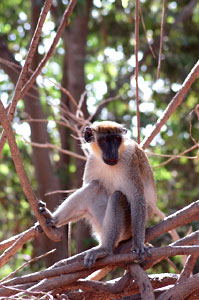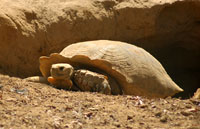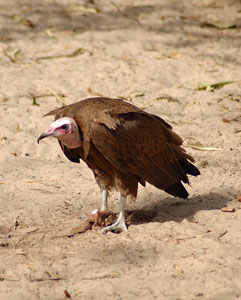Abuko Nature Reserve
 Abuko Nature Reserve is situated outside the
village of Lamin in the Kombo North District, 25km from Banjul. The Reserve has been
protected as a water cachment area since 1916. It was officially declared a Nature Reserve
in 1968. In 1978, a further 29ha were added to the original 76ha, bringing it up to its
current size of 105ha. The Reserve is rectangular in shape, centred on the Lamin stream
which surfaces within the lower half of the Reserve.
Abuko Nature Reserve is situated outside the
village of Lamin in the Kombo North District, 25km from Banjul. The Reserve has been
protected as a water cachment area since 1916. It was officially declared a Nature Reserve
in 1968. In 1978, a further 29ha were added to the original 76ha, bringing it up to its
current size of 105ha. The Reserve is rectangular in shape, centred on the Lamin stream
which surfaces within the lower half of the Reserve.
The central portion of reserve is composed of ground water or gallery forest which surrounds a chain of 3 pools. The dense evergreen forest progressively gives way to Guinea Savannah the further one moves away from the water course, which has a grass and herb dominated understorey. Through the wet season (June to October) the grass grows to almost 2m, but as the dry season progresses it dies back. Within the extension to the reserve is grassland and Guinea Savannah much enjoyed by many Savannah bird species and mammals. Despite its small areas the reserve is also home to a wide diversity of mammals, birds and invertebrates. This is due primarily to its variety of habitat types coupled with the fact that the area was protected in a relatively intact state.
Areas of Interest - Natural
There is something to interest everyone in the Abuko Nature Reserve. It provides a good introduction to the flora, fauna and avi-fauna of The Gambia. Its unique nature allows the visitor to gain an insight into the biodiversity of The Gambia, both present and past. The pools in the Northeast end of the reserve hold a substantial population of Nile crocodiles, and attract a wide variety of birds and mammals, especially during the dry season. The pools also contain quite a variety of fish species.
 Areas
of Interest - Structural
Areas
of Interest - Structural
The education centre overlooks the crocodile pool and offers a splendid view of the pool and its surroundings. The centre is a two-storey structure which houses the environmental education programme. Here school children are shown the importance of conserving their environment through posters, displays and audio visual shows.
There are two photo hides along the route which overlook the upper section of the pools and provide the excellent conditions for photographing and observing the wide range of birds, mammals and reptiles that utilise the pools and their surroundings.
 At the animal orphanage the visitor gets the opportunity to view some examples of
Gambian wildlife up close (spotted hyena, bush buck) as well as lions, now said to be
extinct in the Gambia, apart from the rare vagrants in the east of the country. The
orphanage is also a temporary home to animals and birds that had been held in captivity.
The Department of Parks and Wildlife Management has an ongoing programme of confiscating
captive wild animals - the most common of these are primates and parrots. These animals
are kept at the orphanage until they are ready to be released back into their natural
habitat.
At the animal orphanage the visitor gets the opportunity to view some examples of
Gambian wildlife up close (spotted hyena, bush buck) as well as lions, now said to be
extinct in the Gambia, apart from the rare vagrants in the east of the country. The
orphanage is also a temporary home to animals and birds that had been held in captivity.
The Department of Parks and Wildlife Management has an ongoing programme of confiscating
captive wild animals - the most common of these are primates and parrots. These animals
are kept at the orphanage until they are ready to be released back into their natural
habitat.
There are two refreshment kiosks (one at the animal orphanage and
one at the exit gate) which serve a selection of cold drinks and snacks.
Souveneir buyers will find an extensive range of locally produced
clothing, woodcarvings and other craftwork at the Abuko Craft Market,
located at the exit gate.
Habitat Type - Gallery Forest
Abuko Nature Reserve contains one of the few remaining intact examples of Gallery Forest in The Gambia. It similar in structure to rain forest. The main difference being that it relies on surface water as its primary source of moisture, while rain forest depends on precipation. Because the existence of Gallery Forest is dependent on the presence of surface water, it is only found in areas where there is either a high ground water table or a freshwater source (eg. along the freshwater reaches of the River Gambia).
Gallery Forest is characterised by evergreen forest with a closed canopy and fairly open understorey. The canopy can grow to an excess of 30 metres in height. Gallery forest is a limited habitat type in The Gambia. It found only in Abuko, Pirang Forest Park and in narrow fringes along the river where the water is fresh.
Where river water is brackish (salty) mangrove occurs. Animals and birds who specialise in this habitat type include colobus monkey, dwarf crocodile, Maxwell’s duiker, Gambian sun squirrel and green touraco.
Fauna
Four species of primate occur in the reserve ; the red colobus, the Callithrex monkey, the Patas Monkey and the Senegal bushbaby. Other mammals present include Senegal and Blotched Genets, bush buck, Maxwell’s duiker, Gambian sun squirrel, striped ground squirrel, crested porcupine, bats and a variety of rodents. Reptiles present include Nile and Dwarf Crocodile, Nile and Boscs Monitor, Ngama Lizard, various skinks and geckos, African Rock Python,Royal Puff Adder, Black Necked Cobra and Green Mamba.
The best season for a visit is very much dependent upon what aspect of nature the visitor is seeking. Vegetation in the reserve is most lush in November/December, whereas fauna is better viewed from February-May when vegetation is least concealing. The best time of day to visit the reserve is either early morning or late afternoon as animals tend to seek shelter from the midday sun.
Avi-Fauna
Over 270 species of birds have been recorded from Abuko Nature Reserve which reflects
the value of this small area. The reserve contains an intact pocket of gallery forest in
which numerous forest dependent species occur such as the Green Touraco, little Greenbul
and the Yellow Breasted Apalis. The milky (or Verreaux’s) Eagle Owl is also resident
and often heard calling in the late afternoon. The chain of pools within the lower end of
the reserve attract a tremendous variety of bird life, from the White-Spotted Flufftail to
the African Fish Eagles. An afternoon spent at the Education Centre or one of the photo
hides will yield many good sightings. At the south-western end of the reserve an extension
of 29ha added in 1978 has been appropriately labelled the extension bird walk. The area is
composed of Guinea Savannah with open glades of grassland.
![]()
Last updated on September 21st, 2018
![]()
[Me] [Africa][Culture]
[Links]
[Guest book][The
Stone circles][Serrekunda]
The information on this page was provided by Department of Parks & Wildlife Management, The Gambia. For further information on visiting the protected areas of The Gambia contact the Ecotourism & Training Unit, PO Box 2164, Serrekunda, email wildlife@gamtel.gm